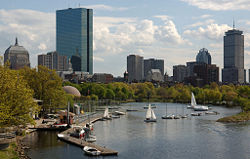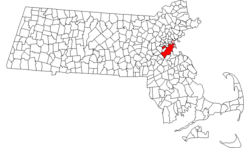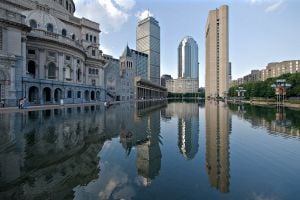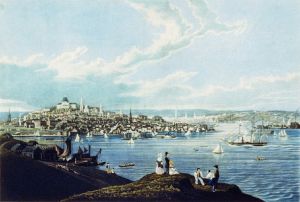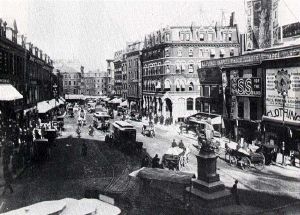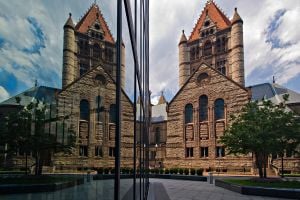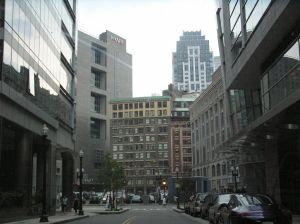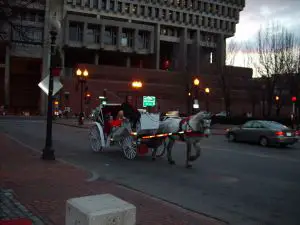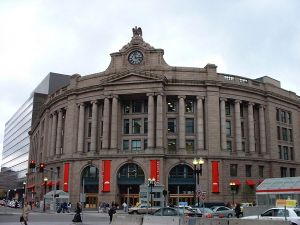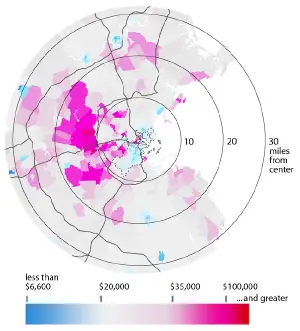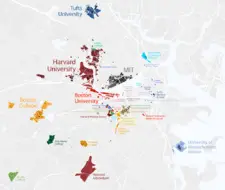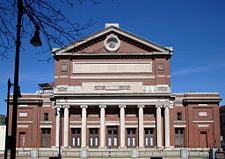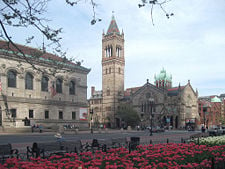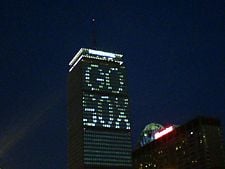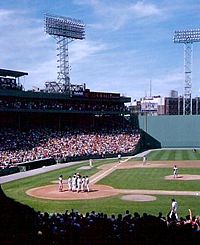| Boston | |||
| — State Capital — | |||
| City of Boston | |||
|
|||
| Nickname: Beantown,[1] The Hub (of the Universe),[1] The Cradle of Liberty,[2] The Cradle of Modern America,[1] The Athens of America,[2] The Walking City[1] | |||
| Motto: Sicut patribus sit Deus nobis (Latin "As God was with our fathers, so may He be with us") | |||
| Location in Suffolk County, Massachusetts | |||
| Coordinates: {{#invoke:Coordinates|coord}}{{#coordinates:42|21|28|N|71|03|42|W|type:city | |||
|---|---|---|---|
| name= }} | |||
| Country | United States | ||
| State | Massachusetts | ||
| County | Suffolk | ||
| Settled | September 17, 1630 | ||
| Incorporated (city) | March 4, 1822 | ||
| Government | |||
| - Type | Strong mayor – council | ||
| - Mayor | Thomas M. Menino (D) | ||
| Area [3][4][5] | |||
| - State Capital | 89.63 sq mi (232.14 km²) | ||
| - Land | 48.43 sq mi (125.43 km²) | ||
| - Water | 41.21 sq mi (106.73 km²) | ||
| - Urban | 1,774 sq mi (4,595 km²) | ||
| - Metro | 4,511 sq mi (11,683 km²) | ||
| - CSA | 10,644 sq mi (27,568 km²) | ||
| Elevation | 141 ft (43 m) | ||
| Population [6][7] | |||
| - State Capital | 617,594 ('10 census) | ||
| - Density | 12,752/sq mi (4,924/km²) | ||
| - Urban | 4,032,484 ('00 census) | ||
| - Metro | 4,522,858 ('08 est.) | ||
| - CSA | 7,609,358 ('09 est.) | ||
| - Demonym | Bostonian | ||
| Time zone | EST (UTC-5) | ||
| - Summer (DST) | EDT (UTC-4) | ||
| ZIP code(s) | 53 total ZIP codes:[8]
| ||
| Area code(s) | 617 and 857 | ||
| FIPS code | 25-07000 | ||
| GNIS feature ID | 0617565 | ||
| Website: www.cityofboston.gov | |||
Boston is one of the oldest cities in the United States. It is the capital and largest city in the state of Massachusetts and the largest city in New England. Boston is considered the economic and cultural center of the region. With a 2008 estimated population of 616,535, Boston is also the anchor of a substantially larger metropolitan area called Greater Boston, home to 4.4 million people and the tenth-largest metropolitan area in the country.
Puritan colonists from England founded the city in 1630. During the late eighteenth century Boston was the location of several major events surrounding the American Revolution, including the Boston Massacre, the Boston Tea Party, and the Battle of Bunker Hill. After independence from Great Britain was attained, Boston became a major shipping port and manufacturing center. Its rich history now attracts 16.3 million visitors annually.
The city was the site of several firsts, including America's first public school, Boston Latin School in 1635. Boston was also home to the first subway system in the United States.
With many colleges and universities such as Harvard and Massachusetts Institute of Technology within the city and surrounding area, Boston is a center of higher education and medicine. The city's economy is based on research, finance, and technology; principally biotechnology. Toward the beginning of the twenty first century, Boston began experiencing gentrification and obtained one of the highest costs of living in the United States, though it remains high on livability rankings.
Geography
Owing to its early founding, Boston is very compact. According to the United States Census Bureau, the city has a total area of 89.6 square miles (232.1 km²)—nearly half of which is water. Through land reclamation and municipal annexation, Boston has expanded beyond the peninsula where it started. Yet it is the fourth most densely populated city in the country not a part of a larger city's metropolitan area. Of United States cities with a population over 500,000, only San Francisco is smaller in land area. The highest point in Boston is Bellevue Hill at 330 feet (101 m) above sea level, while the lowest point is at sea level.
Much of the Back Bay and South End neighborhoods are built on reclaimed land—all the earth from two of Boston's three original hills was used as landfill material. Only Beacon Hill, the smallest of the three original hills, remains partially intact; just half of its height was cut down for landfill.
Climate
Boston has what may basically be described as something between a humid continental climate and a humid subtropical climate, which is common in New England. Summers are warm and humid, while winters are cold, windy, and snowy. Prevailing wind patterns that blow offshore affect Boston, minimizing the influence of the Atlantic Ocean.
Spring in Boston can be warm, with temperatures as high as the 90s when winds are offshore, though it is just as possible for a day in late May to remain in the lower 40s due to cool ocean waters. The hottest month is July, with an average high of 82°F (28°C) and average low of 66°F (18°C). The coldest month is January, with an average high of 36&°F (2&°C) and an average low of 22°F (-6°C).
The city averages about 43 inches (108 cm) of precipitation a year, with 40.9 inches (104 cm) of snowfall a year. Snowfall increases dramatically as one goes inland away from the city and the warming influence of the ocean.
Boston's coastal location on the North Atlantic, though it moderates temperatures, also makes the city very prone to Nor'easter weather systems that can produce much snow and rain. Fog is prevalent, particularly in spring and early summer, and the occasional tropical storm or hurricane can threaten the region, especially in early autumn.
Cityscape
The downtown area and immediate surroundings consist mostly of low-rise brick or stone buildings, with many older buildings in the Federal style. Several of these buildings mix in with modern high-rises, notably in the Financial District, Government Center, the South Boston waterfront, and Back Bay, which includes many prominent landmarks such as the Boston Public Library, Christian Science Center, Copley Square, Newbury Street, and New England's two tallest buildings: the John Hancock Tower and the Prudential Center. Smaller commercial areas are interspersed among single-family homes and wooden/brick multifamily row houses.
Boston Common, located near the Financial District and Beacon Hill, is the oldest public park in the U.S. Along with the adjacent Boston Public Garden, it is part of a string of parks designed by Frederick Law Olmsted to encircle the city. Franklin Park is the city's largest park and houses a zoo. Another major park is the Esplanade located along the banks of the Charles River. Other parks are scattered throughout the city, with the major parks and beaches located near Castle Island, in Charlestown and along the Dorchester, South Boston, and East Boston shorelines.
The Charles River separates Boston proper from Cambridge, Watertown, and the neighborhood of Charlestown. To the east lies Boston Harbor and the Boston Harbor Islands National Recreation Area. The Neponset River forms the boundary between Boston's southern neighborhoods and the city of Quincy and the town of Milton. The Mystic River separates Charlestown from Chelsea and Everett, while Chelsea Creek and Boston Harbor separate East Boston from Boston proper.
History
The Shawmut peninsula was connected to the mainland by a narrow isthmus, and surrounded by the waters of Massachusetts Bay and the Back Bay, an estuary of the Charles River. Several prehistoric Native American archaeological sites excavated in the city have shown that the peninsula was inhabited as early as 5000 B.C.E. Boston's early European settlers first called the area Trimountaine but later renamed the town after Boston, Lincolnshire, England, from which several prominent colonists had emigrated.
Boston was founded on September 17, 1630, by Puritan colonists from England, who were distinct from the Pilgrims who had founded Plymouth Colony ten years earlier. The two groups differed in religious practice, and the separate colonies were not united until the Province of Massachusetts Bay was formed in 1691. Boston was the largest town in British North America until the mid-1700s.
Role in independence
In the 1770s, British attempts to exert more stringent control on the thirteen colonies, primarily via taxation, prompted Bostonians to initiate the American Revolution. The Boston Massacre of 1770 and several early battles occurred in or near the city, including the Battles of Lexington and Concord, Battle of Bunker Hill, and the Siege of Boston.
After the Revolution, Boston became one of the world's wealthiest international trading ports. Exports included rum, fish, salt, and tobacco. In 1822, Boston was chartered as a city.
Manufacturing center
By the mid-1800s, the city's industrial manufacturing overtook international trade in economic importance. Until the early 1900s, Boston remained one of the nation's largest manufacturing centers, and was notable for its garment production and leather goods industries. A network of small rivers bordering the city and connecting it to the surrounding region made for easy shipment of goods and allowed for a proliferation of mills and factories. Later, a dense network of railroads facilitated the region's industry and commerce.
From the mid- to late nineteenth century, Boston flourished culturally; it became renowned for its literary culture and artistic patronage. It also became a center of the abolitionist movement.
In the 1820s, Boston's population began to swell and the city's ethnic composition changed dramatically with the first wave of European immigrants, especially from Ireland. In the latter half of the nineteenth century, the city saw increasing numbers of Irish, Germans, Lebanese, Syrians, French Canadians, and Russian and Polish Jews settle in the city. By the end of the nineteenth century, Boston's neighborhoods had become enclaves of ethnically distinct immigrants. Italians inhabited the North End, the Irish dominated South Boston, and Russian Jews lived in the West End.
Irish and Italian immigrants brought with them Roman Catholicism. Catholics make up Boston's largest religious community, and since the early twentieth century the Irish have played a major role in Boston politics—prominent figures include the Kennedys, Tip O'Neill, and John F. Fitzgerald.
Urban renewal
By the mid-twentieth century, the city was in decline as factories became old and obsolete, and businesses moved out of the region for cheaper labor elsewhere. Boston responded by initiating various urban renewal projects under the direction of the Boston Redevelopment Authority (BRA), which was established in 1957. By the 1970s, the city's economy boomed after thirty years of economic downturn. Hospitals such as Massachusetts General, Beth Israel Deaconess Medical Center, and Brigham and Women's led the nation in medical innovation and patient care. Schools such as Harvard University, MIT, Boston University, Boston College, and Northeastern University attracted students to the area. Nevertheless, the city experienced conflict starting in 1974 over desegregation busing, which resulted in unrest and violence around public schools throughout the mid-1970s.
The Columbia Point housing projects, built in 1953 on the Dorchester peninsula, had gone through bad times until there were only 350 families residing there in 1988. It was run down and dangerous. In 1984, the city of Boston gave control of it to a private developer, Corcoran-Mullins-Jennison, who re-developed and revitalized the property into an attractive residential mixed-income community called Harbor Point Apartments which was opened in 1988 and completed by 1990. It is a very significant example of revitalization and re-development and was the first federal housing project to be converted to private, mixed-income housing in the United States.
By the early twenty-first century the city had become an intellectual, technological, and political center. It had, however, experienced a loss of regional institutions, which included the acquisition of the Boston Globe by the New York Times and the loss to mergers and acquisitions of local financial institutions such as FleetBoston Financial, which was acquired by Charlotte-based Bank of America in 2004. The city also had to tackle gentrification issues and rising living expenses, with housing prices increasing sharply since the 1990s.
Government
Boston has a strong mayor system in which the mayor is vested with extensive executive powers. The mayor is elected to a four-year term by plurality voting. The city council is elected every two years. There are nine district seats, each elected by the residents of that district through plurality voting, and four at-large seats. Each voter casts up to four votes for at-large councilors, with no more than one vote per candidate. The candidates with the four highest vote totals are elected. The president of the city council is elected by the councilors from within themselves. The school committee for the Boston Public Schools is appointed by the mayor. The Boston Redevelopment Authority and the Zoning Board of Appeals (a seven-person body appointed by the mayor) share responsibility for land-use planning.
As the capital of Massachusetts, Boston plays a major role in state politics. The city also has several properties relating to the federal government, including the John F. Kennedy Federal Office Building and the Thomas P. O'Neill Federal Building. The city also serves as the home of the United States Court of Appeals for the First Circuit, the United States District Court for the District of Massachusetts, as well as the headquarters of the Federal Reserve Bank of Boston. The city is in the Eighth and Ninth Congressional Districts.
Economy
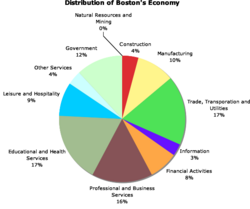
Boston's colleges and universities are not only major employers but they also attract high-tech industries to the city and surrounding region. Boston is also a major hub for biotechnology companies. According to a 2003 report by the Boston Redevelopment Authority, students enrolled in Boston's colleges and universities contribute $4.8 billion annually to the city's economy. Boston also receives the highest amount of annual funding from the National Institutes of Health of all cities in the United States.
Tourism comprises a large part of Boston's economy. In 2004 tourists spent $7.9 billion and made the city one of the ten most popular tourist locations in the country. Other important industries include financial services, especially mutual funds and insurance. The city is also the regional headquarters of major banks and a center for venture capital. Boston is also a printing and publishing center; Houghton Mifflin is headquartered within the city, along with Bedford-St. Martin's Press, Beacon Press, and Little, Brown and Company. The city is home to four major convention centers: The Hynes Convention Center in the Back Bay, the Bayside Expo Center in Dorchester, and the World Trade Center Boston and Boston Convention and Exhibition Center on the South Boston waterfront. Because of its status as a state capital and the regional home of federal agencies, law and government is another major component of the city's economy.
Route 128 serves as the center of the region's high-tech industry. In 2006 Boston and its metropolitan area ranked as the fourth largest cybercity in the United States with 191,700 high-tech jobs. Only NYC Metro, DC Metro and Silicon Valley had bigger high-tech sectors.
The Port of Boston is a major seaport along the United States' East Coast, and is also the oldest continuously operated industrial and fishing port in the Western Hemisphere.
Transportation
Logan International Airport, located in the East Boston neighborhood, handles most of the scheduled passenger service for Boston.
Downtown Boston's streets are not organized on a grid but grew in a meandering organic pattern beginning early in the seventeenth century. They were created as needed, and as wharves and landfill expanded the area of the small Boston peninsula. Along with several rotaries, roads change names and lose and add lanes seemingly at random. On the other hand, streets in the Back Bay, East Boston, the South End, and South Boston do follow a grid system.
Boston is the eastern terminus of I-90. Interstate-95, which surrounds the city, is locally referred to as Route 128, its historical state route numbering. U.S. 1, I-93, and Massachusetts Route 3 run north to south through the city, forming the elevated Central Artery, which ran through downtown Boston and was constantly prone to heavy traffic until it was replaced with an underground tunnel through the "Big Dig."
The Massachusetts Bay Transportation Authority (MBTA) operates what was the first underground rapid transit system in the United States and is now the fourth busiest rapid transit system in the country, having been expanded to 65.5 miles (105& km) of track, reaching as far north as Malden, as far south as Braintree, and as far west as Newton—collectively known as the "T." The MBTA also operates the nation's sixth busiest bus network, as well as water shuttles, and a commuter rail network totaling over 200 miles (321 km), extending north to the Merrimack Valley, west to Worcester, and south to Providence, Rhode Island. Nearly a third of Bostonians use public transit for their commute to work. Nicknamed "The Walking City," pedestrian commutes play a larger role than in comparably populated cities. Owing to factors such as the compactness of the city and large student population, 13 percent of the population commutes by foot, making it the highest percentage of pedestrian commuters in the country out of the major American cities. In its March 2006 issue, Bicycling magazine named Boston as one of the worst cities in the U.S. for cycling;[10] regardless, it has one of the highest rates of bicycle commuting.[11]
Amtrak's Northeast Corridor and Chicago lines originate at South Station and stop at Back Bay. Fast Northeast Corridor trains, which service New York City, Washington, D.C., and points in between, also stop at Route 128 Station in the southwestern suburbs of Boston. Meanwhile, Amtrak's Downeaster service to Maine originates at North Station.
Demographics
According to the census of 2000, there were 589,141 people, (the population estimate of 2006 was 596,638 people),[12] 239,528 households, and 115,212 families residing in the city. The population density was 12,166 people per square mile (4,697/km²). Of major U.S. cities with populations in excess of 250,000, only New York City, San Francisco, and Chicago have a greater population density than Boston.[13] There were 251,935 housing units at an average density of 5,203 per square mile (2,009/km²).
However, the population of Boston can grow during the daytime to about 1.2 million. This fluctuation of people is caused by suburban residents traveling to the city for work, education, medical purposes, and special events. Greater Boston as a commuting region includes parts of Rhode Island and New Hampshire and includes 7.4 million people, making it the fifth-largest Combined Statistical Area in the country.
According to the 2007 American Community Survey, the racial makeup of the city was 57.2 percent white, 23.1 percent African American, 9.0 percent Asian, 0.4 percent Native American, 10.2 percent from other races, and 2.9 percent from two or more races. 16.9 percent of the population was Hispanic of any race. 28.6 percent of the population was foreign born; of this, 48.2 percent came from Latin America, 25.7 percent from Asia, 14.2 percent from Europe, 9.8 percent from Africa and 2.0 percent from other parts of the world.[14]
According to a 2006 estimate, the White population comprises 53.5 percent of the population, while Hispanics make up 15.5 percent.[15] People of Irish descent form the largest single ethnic group in the city, making up 15.8 percent of the population, followed by Italians, accounting for 8.3 percent of the population. People of West Indian ancestry are another sizable group, at 6.4 percent,[16] about half of whom are of Haitian ancestry. Some neighborhoods, such as Dorchester, have received an influx of Vietnamese residents in recent decades. Neighborhoods such as Jamaica Plain and Roslindale have experienced a growing number of Dominican Americans.
Crime
The city has seen a great reduction in violent crime since the early 1990s. Boston's low crime rate in the last years of the twentieth century and the beginning of the twenty-first has been credited to its police department's collaboration with neighborhood groups and church parishes to prevent youths from joining gangs, as well as involvement from the United States Attorney and District Attorney's offices. This helped lead in part to what has been touted as the "Boston Miracle." Murders in the city dropped from 152 in 1990 (for a murder rate of 26.5 per 100,000 people) to just 31—not one of them a juvenile—in 1999 (for a murder rate of 5.26 per 100,000). In more recent years, however, the annual murder count has fluctuated by as much as 50 percent compared to prior year, with 60 murders in 2002, followed by just 39 in 2003, 64 in 2004, and 75 in 2005. Though the figures are nowhere near the high-water mark set in 1990, the aberrations in the murder rate have been unsettling for many Bostonians and have prompted discussion over whether the Boston Police Department should reevaluate its approach to fighting crime.[17]
Healthcare
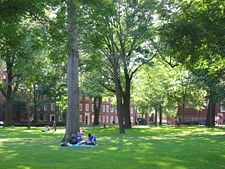
The Longwood Medical Area is a region of Boston with a concentration of medical and research facilities. Many of Boston's major medical facilities are associated with universities. The facilities in the Longwood Medical Area and Massachusetts General Hospital are affiliated with Harvard Medical School. Tufts Medical Center, located in the southern portion of the Chinatown neighborhood, is affiliated with Tufts University School of Medicine. Boston Medical Center, located in the South End neighborhood, is the primary teaching facility for the Boston University School of Medicine as well as the largest trauma center in the Boston area; it was formed by the merger of Boston University Hospital and Boston City Hospital, which was the first municipal hospital in the United States.
Education
Elementary and secondary
Boston Public Schools, the oldest public school system in the United States, enrolls 57,000 students. The system operates 145 schools, which includes Boston Latin School (the oldest public school in the United States, established in 1635), English High (the oldest public high school, established 1821), and the Mather School (the oldest public elementary school, established in 1639). The city also has private, parochial, and charter schools. Three thousand students of racial minorities attend participating suburban schools through the Metropolitan Educational Opportunity Council, or METCO.
In 2002, Forbes magazine ranked the Boston Public Schools as the best large city school system in the country, with a graduation rate of 82 percent. In 2005, the student population was 45.5 percent black or African American, 31.2 percent Hispanic or Latino, 14 percent white, and 9 percent Asian, as compared with 24 percent, 14 percent, 49 percent, and 8 percent, respectively, for the city as a whole.[18]
Colleges and universities
Boston's reputation as the Athens of America derives in large part from the teaching and research activities of more than 100 colleges and universities located in the Greater Boston area, with more than 250,000 students attending college in Boston and Cambridge alone. Within the city, Boston University is the city's fourth-largest employer.
Boston is also home to several conservatories and art schools, including the Art Institute of Boston, Massachusetts College of Art, and the New England Conservatory of Music (the oldest independent conservatory in the United States). Boston has one major public university, the University of Massachusetts, Boston, while Roxbury Community College and Bunker Hill Community College are the city's two community colleges.
Culture
Boston shares many cultural roots with greater New England, including an accent known as Boston English and a regional cuisine with a large emphasis on seafood, rum, salt, and dairy products.
Many consider Boston to have a strong sense of cultural identity, perhaps as a result of its intellectual reputation; much of Boston's culture originates at its universities.
The city has several ornate theaters, including the Cutler Majestic Theatre, Boston Opera House, Citi Performing Arts Center, and the Orpheum Theatre. Renowned performing arts organizations include the Boston Symphony Orchestra, Boston Ballet, Boston Pops, Celebrity Series of Boston, Boston Early Music Festival, Boston Lyric Opera Company, OperaBoston, Emmanuel Music, and the Handel and Haydn Society (one of the oldest choral companies in the United States).
Because of the city's prominent role in the American Revolution, several historic sites relating to that period are preserved as part of the Boston National Historical Park. Many are found along the Freedom Trail. The city is also home to several prominent art museums, including the Museum of Fine Arts and the Isabella Stewart Gardner Museum. The Boston Athenaeum (one of the oldest independent libraries in the United States), Boston Children's Museum, Museum of Science, and the New England Aquarium are within the city.
Media
The Boston Globe (owned by the New York Times Company) and the Boston Herald are Boston's two major daily newspapers.
Boston has the largest broadcasting market in New England, with the Boston radio market being the eleventh largest in the United States.
The Boston television marketing area, which also includes Manchester, New Hampshire, is the seventh largest in the United States. The city is served by stations representing every major American network.
Sports
Boston's major league teams—The Boston Red Sox, Boston Celtics, Boston Bruins, and New England Patriots—have won a greater percentage of championships per season played than the teams of any other four-sport city. The Boston Red Sox are a founding member of the American League of Major League Baseball and were the 2007 World Series champions. The team plays its home games at Fenway Park. Built in 1912, it is the oldest sports arena or stadium in active use in the United States among the four major professional sports. Boston was also the site of the first game of the first modern World Series, in 1903. The series was played between the Red Sox and the Pittsburgh Pirates.
The Boston Celtics were founding members of the Basketball Association of America, one of the two leagues that merged to form the National Basketball Association (NBA). The Celtics have the distinction of having more national titles than any other NBA team, with 17 championships from 1957 to 2008.
Although the team has played in suburban Foxboro since 1971, the New England Patriots are Boston's football team. The team was founded in 1960 as the Boston Patriots, a charter member of the American Football League, and in 1970 the team joined the National Football League. The team won Super Bowl titles in 2001, 2003, and 2004.
One of the most famous sporting events in the city is the Boston Marathon, the 26.2 mile (42.2 km) run from Hopkinton to Copley Square in the Back Bay. The Marathon, the world's oldest, is popular and heavily attended.
Boston is bidding to host the 2020 Summer Olympics.
Looking to the future
Mayor Thomas Menino has indentified eight major goals for the city:[19]
- Closing the academic achievement gap between white and Asian students and black and Hispanic students
- Reducing violent crime
- Increasing the supply of affordable housing for working families in Boston, including programs aimed at helping first-time homebuyers, as well as educating homeowners about the dangers of predatory lending and foreclosure prevention
- Improving city services by, for example, utilizing new technology and service delivery methods to improve city services at the same or lower cost
- Creating new jobs by creating and expanding partnerships and intensive marketing outreach to attract new businesses to the Boston area and expand existing ones
- Narrowing racial and ethnic disparities in health care; the city is implementing recommendations of a task force in this area and has already coordinated more than $1 million in grants to dozens of local health organizations
- Increasing diversity in government by recruiting, hiring, and training a diverse city workforce and creating a culturally welcoming environment
- Growing revenue by pursuing new revenue streams
Notes
- ↑ 1.0 1.1 1.2 1.3 Dalager, Norman, "What's in a nickname?", Boston Globe, August 10, 2006. Retrieved April 8, 2009.
- ↑ 2.0 2.1 Boston Travel & Vacations. Britannia.com (2006). Retrieved April 8, 2009.
- ↑ Massachusetts by Place and County Subdivision. American FactFinder. United States Census Bureau, Census 2000 Summary File 1. Retrieved April 29, 2009.
- ↑ United States by Urbanized Area; and for Puerto Rico. American FactFinder. United States Census Bureau, Census 2000 Summary File 1. Retrieved April 29, 2009.
- ↑ United States by County by State, and for Puerto Rico. American FactFinder. United States Census Bureau, Census 2000 Summary File 1. Retrieved April 29, 2009.
- ↑ Population and Housing Occupancy Status: 2010 – State – County Subdivision, 2010 Census Redistricting Data (Public Law 94-171) Summary File. U.S. Census Bureau. Retrieved March 23, 2011.
- ↑ Error on call to template:cite web: Parameters url and title must be specified (TXT). United States Census Bureau, Geography Division.
- ↑ ZIP Code Lookup – Search By City. United States Postal Service. Retrieved April 20, 2009.
- ↑ City-Data.com, 2007, Boston Economy. Retrieved January 11, 2009.
- ↑ Nina MacLaughlin, 2006, Boston Can Be Bike City...If You Fix These Five Big Problems, The Phoenix—Bicycle Bible. Retrieved January 12, 2009.
- ↑ Jennifer Dill and Theresa Carr, 2003, Bicycle Commuting and Facilities in Major U.S. Cities: If You Build Them, Commuters Will Use Them—Another Look, University of California, Davis. Retrieved January 12, 2009.
- ↑ U.S. Census Bureau, Population Division, Accepted Challenges to Vintage 2005 Population Estimates.
- ↑ Wendell Cox Consultancy, US Cities Over 100,000: Ranked by Population Density: 1990. Retrieved January 12, 2009.
- ↑ U.S. Census Bureau, Boston city, Massachusetts ACS Demographic and Housing Estimates: 2007. Retrieved January 12, 2009.
- ↑ Sperling's Best Places, Boston, Massachusetts. Retrieved January 12, 2009.
- ↑ United States Census Bureau, Boston city, Massachusetts Profile of Selected Social Characteristics: 2000. Retrieved January 12, 2009.
- ↑ Christopher Winship, March 2002, End of a Miracle? Crime, Faith, and Partnership in Boston in the 1990s, Harvard University. Retrieved January 12, 2009.
- ↑ Boston Globe, Boston public schools. Retrieved January 12, 2009.
- ↑ The City of Boston, Mayor's Priorities. Retrieved January 12, 2009.
ReferencesISBN links support NWE through referral fees
- City of Boston. Records Relating to the Early History of Boston - Selectmen Minutes 1818-1822. City of Boston Publishers. Digitized by Google, 1909. Retrieved April 28, 2020.
- Dowst, Henry P. Random Notes of Boston. Humphrey Publishing, 1916. Retrieved April 28, 2020.
- Gershkoff, Ira, and Richard Trachtman. The Boston Driver's Handbook: The Almost Post Big Dig Edition. Cambridge, MA: Da Capo Press, 2004. ISBN 0306813262
- Harris, Patricia, and David Lyon. Boston. Oakland, CA: Compass American Guides, 1999. ISBN 0679002847
- Jones, Howard Mumford, and Bessie Zaban Jones. The Many Voices of Boston: A Historical Anthology, 1630-1975. Boston: Little, Brown, 1975. ISBN 0316472824
- Rambow, John D. 2003. Fodor's Boston. New York: Fodor's Travel Publications. ISBN 1400010284.
- Seasholes, Nancy S. Gaining Ground: A History of Landmaking in Boston. Cambridge, MA: MIT Press, 2003. ISBN 978-0262194945
- Snow, Caleb H. History of Boston. Abel Bowen Press. Digitized by Google, 1828. Retrieved April 28, 2020.
- Vanderwarker, Peter. Boston Then & Now: 59 Boston Sites Photographed in the Past and Present. New York: Dover Publications, 1982. ISBN 0486243125
- Winsor, Justin. Memorial History of Boston, Vol.1. James R. Osgood Publisher, 1881. Retrieved April 28, 2020.
External links
All links retrieved November 20, 2023.
- City of Boston official website
- Greater Boston Chamber of Commerce
- Greater Boston Convention & Visitors Bureau
Credits
New World Encyclopedia writers and editors rewrote and completed the Wikipedia article in accordance with New World Encyclopedia standards. This article abides by terms of the Creative Commons CC-by-sa 3.0 License (CC-by-sa), which may be used and disseminated with proper attribution. Credit is due under the terms of this license that can reference both the New World Encyclopedia contributors and the selfless volunteer contributors of the Wikimedia Foundation. To cite this article click here for a list of acceptable citing formats.The history of earlier contributions by wikipedians is accessible to researchers here:
The history of this article since it was imported to New World Encyclopedia:
Note: Some restrictions may apply to use of individual images which are separately licensed.
